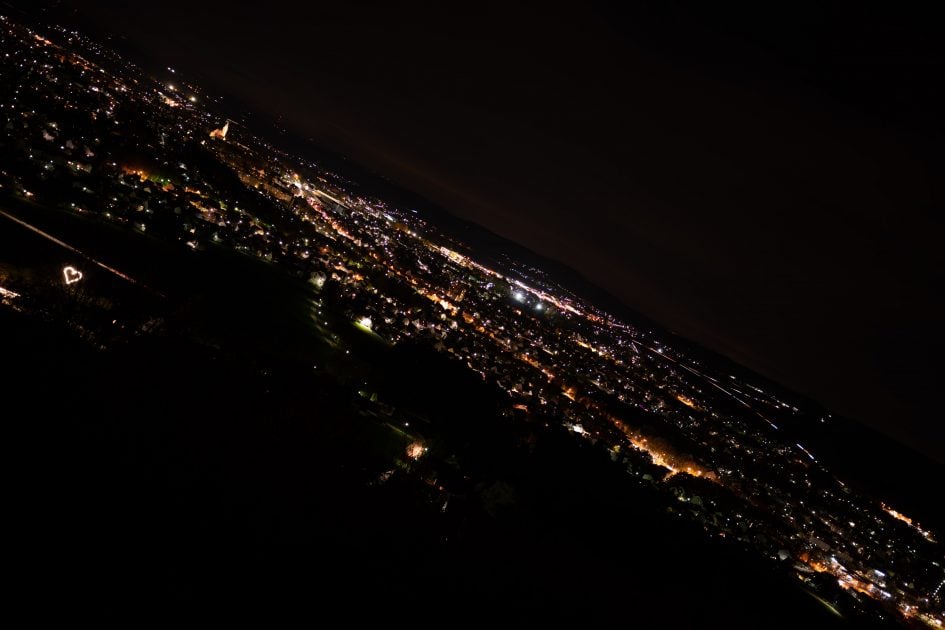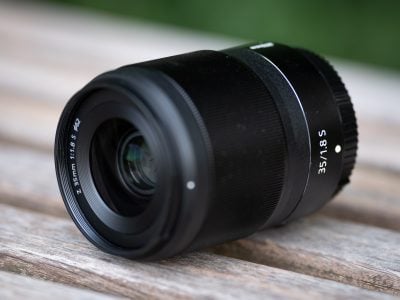Nikon Z 35mm f1.8S review
-
-
Written by Thomas
Quality
Testing: Longitudinal Chromatic Aberration and focus shift
Lenses with focal ratios of f2.8 or larger are often prone to longitudinal color aberrations (loCA, a.k.a. “axial color” or “bokeh CA”). These show up as magenta coloration in the foreground and greenish hues in the background and are not easily corrected in post-processing. The new Nikon is no exception: it shows quite some loCA at f1.8 and f2.8.
Nikon Z 35mm f1.8S Longitudinal Chromatic Aberration (loCA)
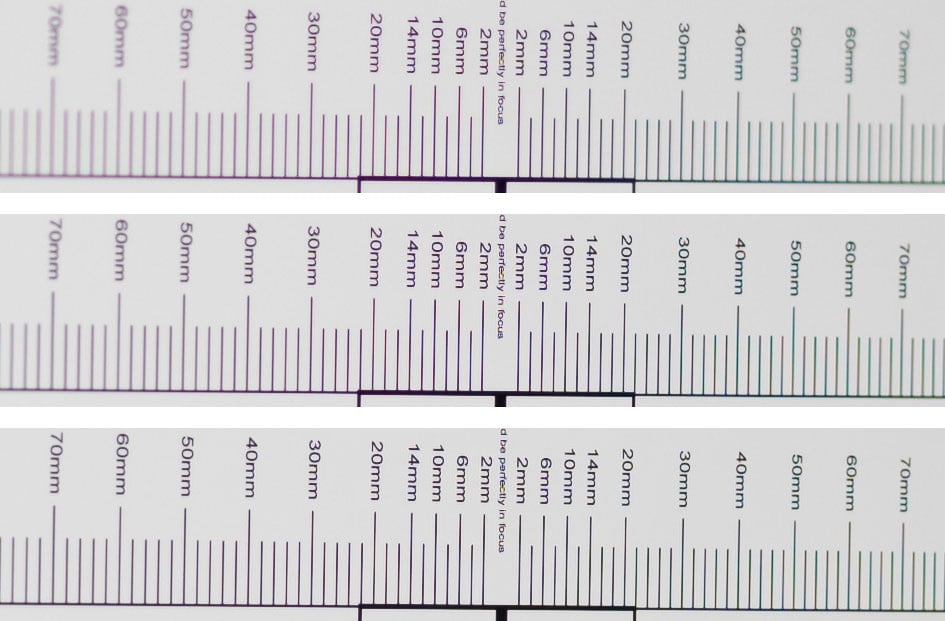
100% crops, from top to bottom: f1.8, f2.8, f4.0; left = foreground, right = background
The test also revealed that there is no focus shift to speak of at distances of 2m and farther away although the background sharpens up much faster than the foreground when the lens is stopped down.
LoCA also clearly show up under real-life conditions as you can see in the following crop:

Above: Nikon Z 35mm f1.8S at f1.8; 100% crop
To put the results from the new Z Nikkor in perspective let’s have a look at the Zeiss 28mm f1.4 Otus. It shows that even a lens designated “apochromatic” can still show some loCA:
Zeiss 28mm f1.4 Otus Longitudinal Chromatic Aberration (loCA)
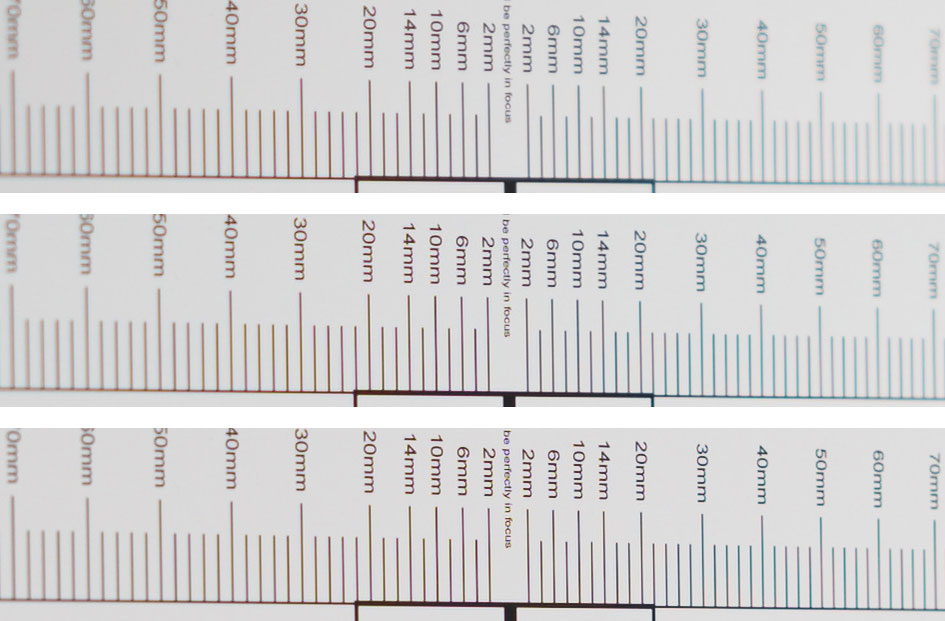
100% crops, from top to bottom: f1.4, f2.0, f2.8; left = foreground, right = background
Sharpness and contrast
Let’s have a look at the theoretical performance of the new Nikon Z 35mm f1.8S first and compare it to the performance of the Nikon 35mm f1.8G and the Zeiss 28mm f1.4 Otus:
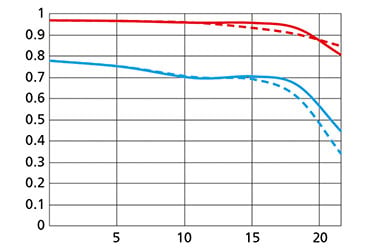
Above: MTF Nikon Z 35mm f1.8S at f1.8
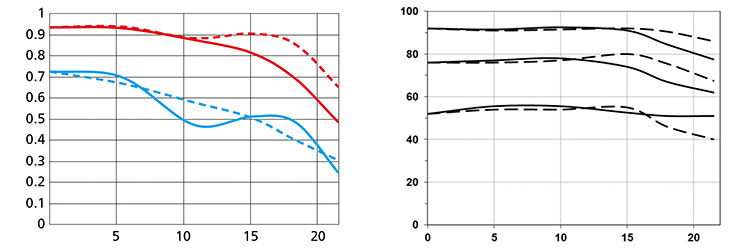
Above: MTF Nikon 35mm f1.8G (left), Zeiss 28mm f1.4 Otus (right)
These MTF charts of the Nikon lenses show the computed lens-performance wide open without influence of diffraction. Higher values are better (more contrast) and the closer the line-pairs are together the less astigmatism (= resolution depends on the orientation of the test-pattern) the lens has. The x-axis displays the distance from the optical axis (=center of the sensor) in mm. I’ll show you the real-life performance at 4 mm (center), 13 mm (APS-C/DX-corner), and 20 mm (FF/FX-corner) on a 46MP Nikon Z7 body.
While Nikon displays the contrast-curves at 10 line-pairs/mm (in red) and 30 lp/mm (in blue) Zeiss displays the measured contrast-curve (which includes the effects from diffraction) at 10, 20 and 40 lp/mm (from top to bottom), which is a bit unusual.
From the charts the new Nikon Z 35mm f1.8S should have a clear advantage over the older Nikon 35mm f1.8G. The older Nikon has a distinct drop in resolution of fine details at 10mm image height and then again towards the extreme corner of a full-frame sensor. The Zeiss Otus shows its hallmark performance where overall contrast and the reproduction of fine details stays almost the same across the full-fame sensor.
Let’s see how this theoretical performance of Nikon’s new Z Nikkor translates into real life results in the sharpness test based on Siemens-stars. Processing was done in Lightroom 8/CRAW 11 from RAW to Adobe Color profile with the built-in lens profile applied. Noise-reduction is set to 0, sharpening to 50/0.5/36/10, with no extra tone, color, or saturation adjustment. White-balance was adjusted to a neutral white and I did some exposure compensation to make the brightness of all crops match. So you will not see light fall-off in the corners. Removal of lateral color aberrations is ON, longitudinal CA are not corrected.
The following 100% crops show the new Nikon Z 35mm f1.8S from f1.8 down to f11 compared to the Zeiss 28mm f1.4 Otus at f1.8 and f4.0 plus the Nikon Z 24-70mm f4S at f4.0. I also inserted comparable shots from the Nikon 35mm f1.8G and the Tamron 35mm f1.8 VC at f1.8 and f4.0. Those lenses were shot on a 36MP D800/D810 and I adapted sharpening accordingly. The linear resolution of the D800/D810 sensor is 12% lower which should also give these older lenses a slight advantage in this comparison. But you still can get a good idea how they perform. No lens profiles were applied to the Zeiss Otus, the Nikon 35mm f1.8G, and the Tamron.
Nikon Z 35mm f1.8S; 100% crop from center, APS-C/DX-corner, FF/FX-corner

Above: Nikon Z 35mm f1.8S at f1.8

Above: Zeiss 28mm f1.4 Otus at f1.8; also available at f1.4, f1.6, f2.0, f2.8, f4.0, f5.6, f8.0, f11

Above: Nikon 35mm f1.8G on a D800 at f1.8

Above: Tamron 35mm f1.8 VC on a D810 at f1.8
At f1.8 the Nikon Z 35mm f1.8S holds it own against the reference Otus lens with a slightly softer FX-corner. The older Nikon 35mm f1.8G on a D800 is not much behind in the APS-C/DX image-circle but becomes clearly soft in the FX-corner. And the Tamron is very sharp in the center (at the cost of some loCA) but is already pretty soft at the DX-corner.
Now let’s see how the new Z Nikkor develops when stopped down:

Above: Nikon Z 35mm f1.8S at f2.0

Above: Nikon Z 35mm f1.8S at f2.8

Above: Nikon Z 35mm f1.8S at f4.0

Above: Zeiss 28mm f1.4 Otus at f4.0

Above: Nikon 35mm f1.8G on a D800 at f4.0

Above: Tamron 35mm f1.8 VC on a D810 at f4.0

Above: Nikon Z 24-70mm f4S at 35mm, f4.0; also available at f5.6, f8.0, f11
The new Nikon Z 35mm f1.8S sharpens up quite nicely when stopped down to f4 coming very close to the Zeiss Otus which still has the sharper FX-corner. The Tamron scores a good third place with the older Nikon 35mm f1.8G trailing it with the weakest FX-corner of the four prime lenses. And the new entry in this comparison, the Nikon Z 24-70mm f4S zoom lens, proves it’s worth against the primes with very respectable performance.

Above: Nikon Z 35mm f1.8S at f5.6

Above: Nikon Z 35mm f1.8S at f8.0

Above: Nikon Z 35mm f1.8S at f11
Overall Nikon’s new Z 35mm f1.8S lens proves its merit against my reference wide angle lens in this class, the Zeiss 28mm f1.4 Otus. The Z Nikkor may lag a bit behind in the FX-corner but it is a clear improvement over its F-mount predecessor, the Nikon 35mm f1.8G.
Performance at long distances
The Siemens-star test-targets are shot at a distance of 45x focal length (i.e. at around 3m for 70mm focal length). But performance of lenses also depends on the shooting distance. Therefore I present another series of test-shots of a city around 1 km away. Processing was done in Lightroom 8/CRAW 11 from RAW to Adobe Color profile with the lens-profile for distortion and vignetting automatically applied. Noise-reduction is set to 0, sharpening to 50/0.5/36/10, with no extra tone, color, or saturation adjustment. I used autofocus at the largest aperture and did not change focus for other apertures. All shots were made at ISO 64 and VR switched off.
The main image shows the complete scene wide open to give you an impression of the angle of view and to judge vignetting. You can access the respective shots up to f11 via the links beneath the main image. Following the main image are 100% crops from the new Nikon Z 35mm f1.8S down to f11 compared to the Zeiss 28mm f1.4 Otus at f1.8 and f4.0 plus the Nikon Z 24-70mm f4S at 35mm, f4.0. Both prime lenses were shot on the same day only minutes apart. The zoom was shot another day under similar atmospheric conditions. The Zeiss Otus is a bit disadvantaged in this comparison as due to its 20% shorter focal length it has a lower magnification of the scene. No lens profile was applied to the Zeiss Otus.
You can click on each image to access the large original. Please respect our copyright and only use those images for personal use.
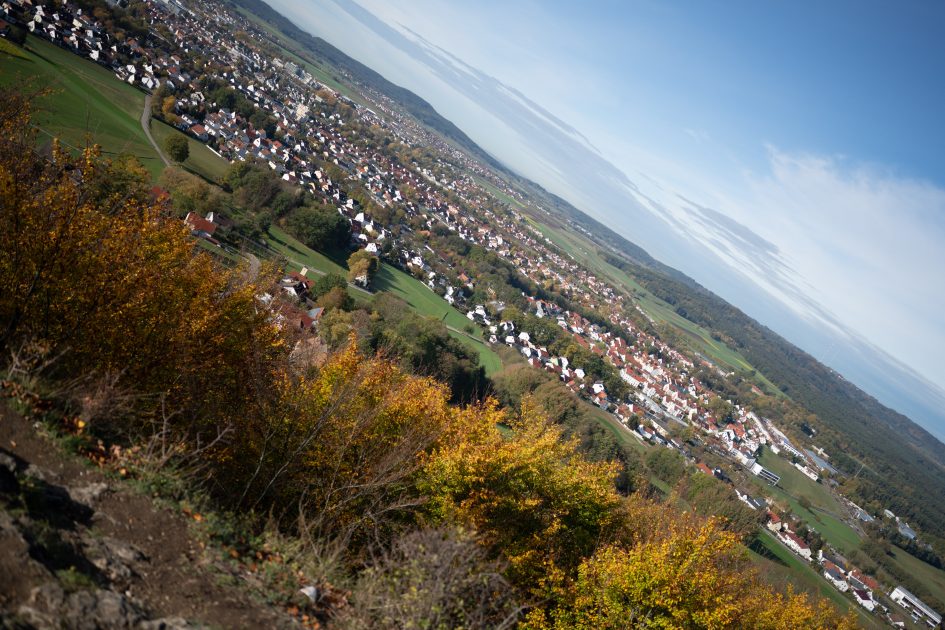
Above: Nikon Z 35mm f1.8S at f1.8; click image to access original at Flickr; also available at f2.0, f2.8, f4.0, f5.6, f8.0, f11

Above: Nikon Z 35mm f1.8S at f1.8; 100% crop from center, APS-C/DX-corner, FF/FX-corner

Above: Zeiss 28mm f1.4 Otus at f1.8; 100% crop from center, APS-C/DX-corner, FF/FX-corner; also available at f1.4, f1.6, f2.0, f2.8, f4.0, f5.6, f8.0, f11
The Nikon Z 35mm f1.8S looks sharper than the Zeiss Otus in the DX-corner. Impressive! Let’s see how the new Z Nikkor develops when stopped down:

Above: Nikon Z 35mm f1.8S at f2.0; 100% crop from center, APS-C/DX-corner, FF/FX-corner

Above: Nikon Z 35mm f1.8S at f2.8; 100% crop from center, APS-C/DX-corner, FF/FX-corner

Above: Nikon Z 35mm f1.8S at f4.0; 100% crop from center, APS-C/DX-corner, FF/FX-corner

Above: Zeiss 28mm f1.4 Otus at f4.0; 100% crop from center, APS-C/DX-corner, FF/FX-corner

Above: Nikon Z 24-70mm f4S at 35mm, f4.0; 100% crop from center, APS-C/DX-corner, FF/FX-corner; also available at f5.6, f8.0, f11
The new Nikon Z 35mm f1.8S is sharper in the DX- and the FX-corner than the Zeiss Otus. Who would have thought that? And the new entry in this comparison, the Nikon Z 24-70mm f4S zoom lens, also performs very nicely at f4.0.

Above: Nikon Z 35mm f1.8S at f5.6; 100% crop from center, APS-C/DX-corner, FF/FX-corner

Above: Nikon Z 35mm f1.8S at f8.0; 100% crop from center, APS-C/DX-corner, FF/FX-corner

Above: Nikon Z 35mm f1.8S at f11; 100% crop from center, APS-C/DX-corner, FF/FX-corner
The new Nikon Z 35mm f1.8S comes in first place over the Zeiss Otus in this long-distance test. Even wide open it produces a slightly sharper DX-corner and pulls ahead when stopped down in the FX-corner, too.
Vignetting and distortions
Vignetting and distortions are lens aberrations that can be easily corrected by software. Lightroom (LR) and Photoshop (PS) have offered lens profiles for some time which could be applied as an option. But with the Z series, like most mirrorless systems, Adobe applies lens profiles automatically whether you want them or not. You can select the degree of Vignette Control in camera between High, Normal, Low, and Off – which is then also applied by LR and PS to the RAW files – without the option to change the setting. But in Nikon’s own free Capture NX-D software (V1.5.0) the degree of Vignette Control can be changed. Auto Distortion Control can also be enabled or disabled in camera and in Capture NX-D – but not in LR or PS where it’s always turned On. Interestingly, this is only true for the Nikon Z 35mm f1.8S. The Nikon Z 24-70mm f4S does not allow to switch off Auto Distortion Control – neither in camera nor in Capture NX-D. The Nikon Z7 reference manual simply notes “that Off may not be available with some lenses”.
To make it easier to see light fall-off in the corners of a full-frame sensor I’ve arranged a series of shots with the new Z Nikkor at different apertures. All images were developed to the same brightness in the center and the lens profile applied, Vignette Control in camera was set to Normal (the default):
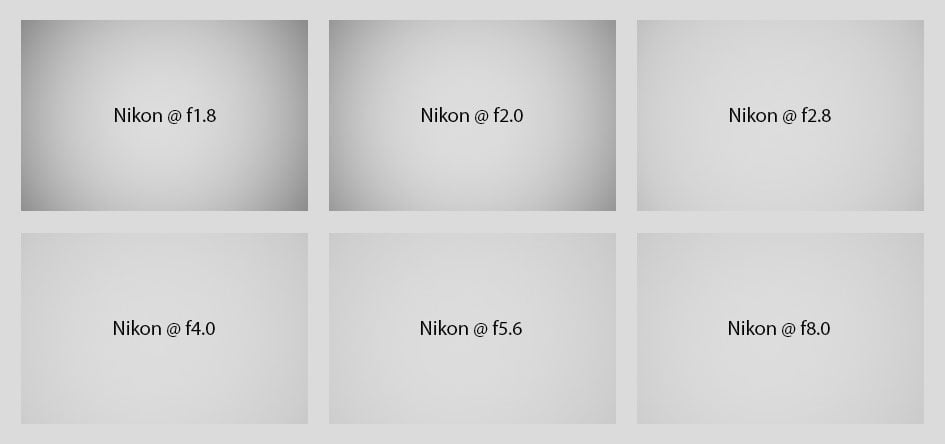
Above: Nikon Z 35mm f1.8S
The sample images above show that even with the lens profile applied vignetting remains visible until f2.8. See the Zeiss 28mm f1.4 Otus with the Adobe lens profile applied in comparison:

Above: Zeiss 28mm f1.4 Otus at f1.4, f2.0, f2.8
Adobe goes for a much stronger vignette compensation with the Zeiss Otus than Nikon does with its Z Nikkor.
Distortions of the new Z 35mm f1.8S are very well corrected through Nikon’s lens profile as you can see in the examples at the end of the samples page.
Rendering of point-light sources at night-shots
Night-shots pose a different challenge for lenses as the contrast is even higher than under bright sun and point-light sources can reveal some weaknesses such as coma, haloing and colour-aberrations that do not show up as prominently in other test-shots. The 100% crops below the main image show the effect of coma in the FF/FX-corner of the new Z Nikkor and the Zeiss 28mm f1.4 Otus at various apertures:
Above: Nikon Z 35mm f1.8S at f1.8; click image to access original at Flickr; also available at f2.0, f2.8, f4.0, f5.6

Above: Nikon Z 35mm f1.8S; 100% crops from the FF/FX-corner at f1.8 (left), f2.8 (middle), f4.0 (right)

Above: Zeiss 28mm f1.4 Otus; 100% crops from the FF/FX-corner at f1.8 (left), f2.8 (middle), f4.0 (right)
The new Nikon Z 35mm f1.8S has a little less coma wide open than the already pretty good Zeiss 28mm f1.4 Otus. And at f4.0 the Z Nikkor is free of coma while the Zeiss Otus still retains some.
Rendering of out-of-focus point-light sources
This test is for the rendering of point-light sources in an out-of-focus background. The circle of confusion that is produced by this test is pretty indicative of Bokeh performance (in the background) and light fall-off. Ideally the out-of-focus image of the point-light is evenly lit and perfectly circular, with no “onion-rings”, and without coloration. Large aperture lenses normally produce an effect known as “cat’s eye” the further away from the optical axis the point-light is projected. This is due to optical vignetting in the lens barrel when light enters the lens from an angle.
All images were shot at the longest focal length and largest aperture. The new Nikon is first followed by the Zeiss 28mm f1.4 Otus.
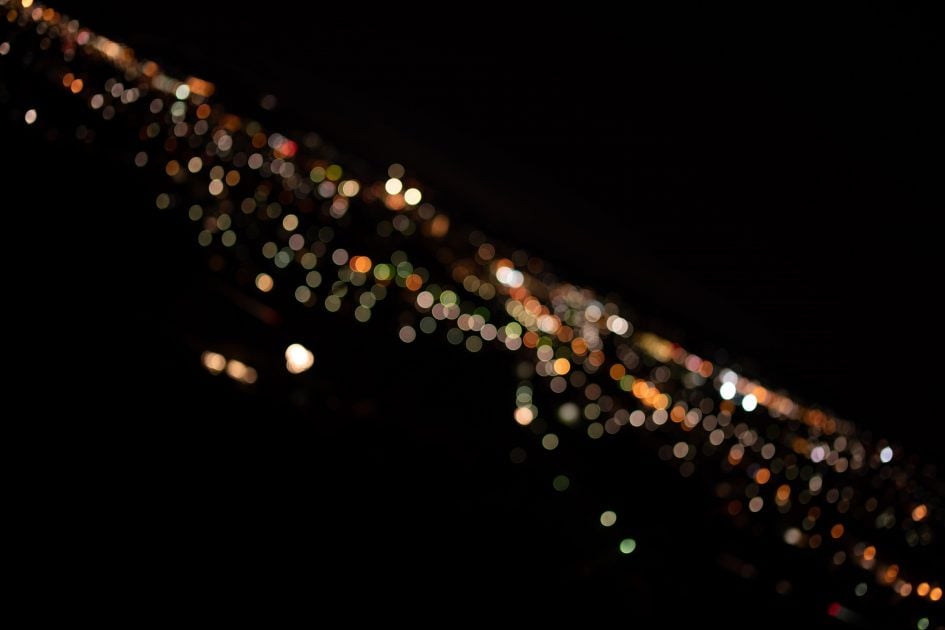
Above: Nikon Z 35mm f1.8S at f1.8; click image to access original at Flickr; also available at f2.0, f2.8, f4.0, f5.6, f8.0

Above: Nikon Z 35mm f1.8S at f1.8; 44% crops from center, DX-corner, FX-corner

Above: Zeiss 28mm f1.4 Otus on a D810 at f1.4; 50% crops from center, DX-corner, FX-corner; also available at f2.0, f2.8, f4.0, f5.6, f8.0
When shot wide open both lenses produce Bokeh balls of similar size in the center. But the new Z 35mm f1.8S shows a slightly brighter border with an additional green outline (due to loCA) of which the Zeiss 28mm f1.4 Otus is free. Texture within the circle is softer with the Zeiss Otus but the Z Nikkor also shows no strong onion rings. Bokeh balls of both lenses are already slightly compressed at the DX-corner where the Zeiss Otus retains the larger Bokeh balls.
Now let’s see how this analysis of out-of-focus point-light sources translates into Bokeh-performance shooting a book-shelf.
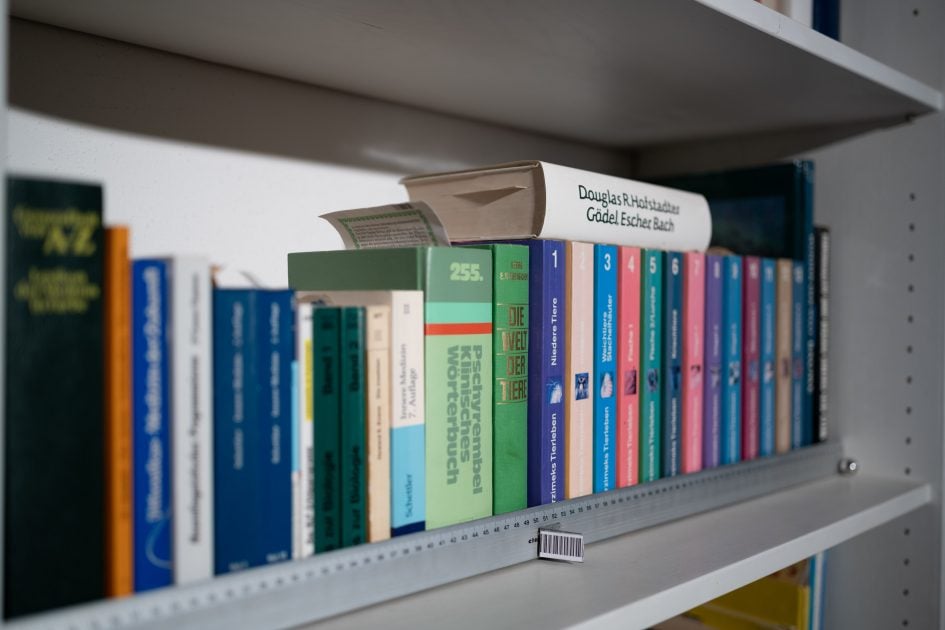
Above: Nikon Z 35mm f1.8S at f1.8; click image to access original at Flickr; also available at f2.0, f2.8, f4.0, f5.6, f8.0

Above: Nikon Z 35mm f1.8S at f1.8; 44% crops from foreground, middle-ground, background

Above: Zeiss 28mm f1.4 Otus on a D810 at f1.4; 50% crops from foreground, middle-ground, background; also available at f1.8, f2.0, f2.8, f4.0, f5.6, f8.0
Both lenses perform pretty comparable wide open as the benefit of the larger f1.4 aperture of the Zeiss Otus is counter-acted by the longer focal length of the Z Nikkor. But the new Nikon Z 35mm f1.8S suffers from more longitudinal CA which can be seen in the stronger greenish coloration in the transition zone. And it can look very nervous and distracting farther towards the background as the following crop shows:

Above: Nikon Z 35mm f1.8S at f1.8; 100% crop from background
That does certainly not qualify as a creamy Bokeh.
Close-up performance
As the new Z Nikkor goes down to 1:4.8 magnification let’s see how the lens performs in close-up shooting. The following image was shot at 1:5 magnification where the area of sharp focus is just 120 x 180mm. The crops shown below are from 1.5mm, 6mm, and 14mm off the center of the sensor respectively:

Above: Nikon Z 35mm f1.8S at f1.8, 1:5 magnification; 100% crops

Above: Nikon Z 24-70mm f4S VR at 70mm, f5.6, 1:4 magnification; 100% crops at 2mm, 8mm, and 17mm image height
The new Z Nikkor has a close-up performance at f1.8 that is even better than from the Nikon Z 24-70mm f4S at f5.6. It easily makes up for the slightly lesser magnification. Impressive!
Flare, ghosting, and sun-stars
Catching a strong light-source shining directly into the lens is always a risky business: it could produce strange colourful ghost-images or reduce contrast considerably through flare and glare. The appearance of flare and ghosting depends on factors like the aperture and the angle of the light hitting the lens. So to judge the proclivity of the new Nikon Z 35mm f1.8S for these artefacts I went through a series of well calculated shots against a strong light source to provoke glare and ghosting.
The new Nikon Z 35mm f1.8S is very clear of flare and ghosting artefacts. And outside these artefacts the new lens renders a very deep black, so there’s little veiling glare. See two examples at f11 where the effects are most obvious:
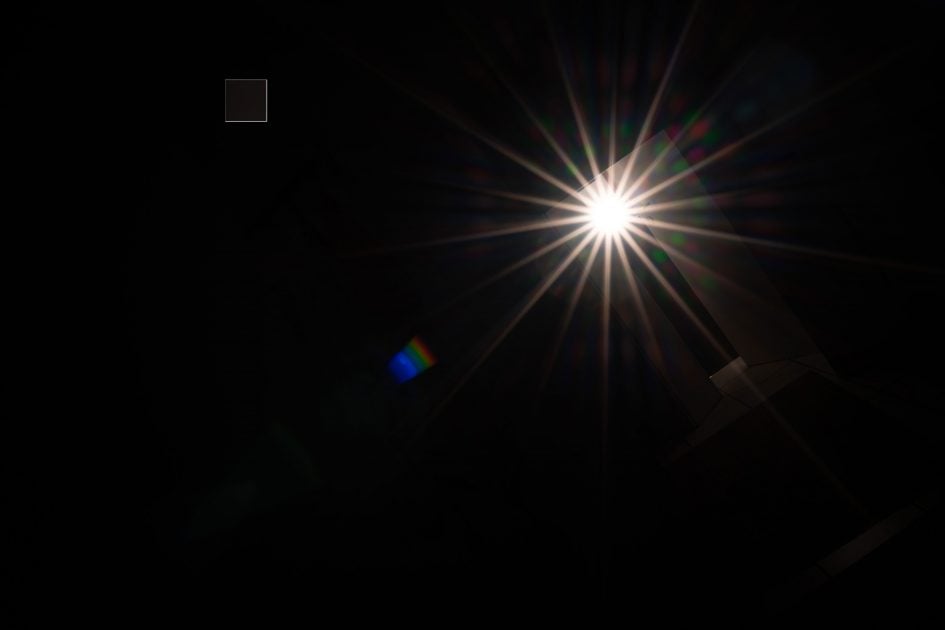
Above: Flare and ghosting. Strong light hitting the Nikon Z 35mm f1.8S at f11
The little square inset in the upper left of the image shows the respective area with an exposure compensation of +3 EV to make it easier to see which levels of black the lens renders at that point. It clearly shows that the Nikon Z 35mm f1.8S produces very little veiling glare and deep blacks.
The new Nikon Z 35mm f1.8S produces quite nice sunstars even at f5.6 and more so when you close the lens even further. But this test also reveals that the Z7 is prone to adding some colorful “teardrops” to the sunstars. I’ve seen the same effect now from three lenses on the Z7 and it seems that it is some reflection from the new sensor of the Z7 as I had no such effects with the D850 or D810. The effect can not always be seen though as the following crop from a nightshot shows:

Above: Sunstars from the Nikon Z 35mm f1.8S at f5.6, 100% crop
Watch out, when the light-source is just outside the corner where it throws a streak of light across the sensor:
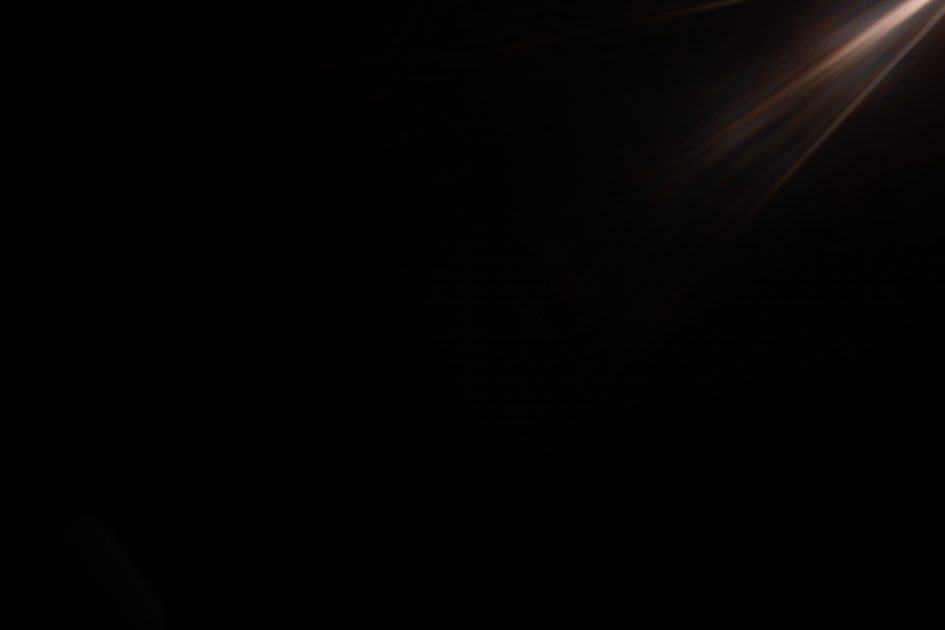
Above: Flare and ghosting. Strong light hitting the Nikon Z 35mm f1.8S at f11
Next check out my sample images!
Check prices on the Nikon Z 35mm f1.8S at Amazon, B&H, Adorama, or Wex. Alternatively get yourself a copy of my In Camera book or treat me to a coffee! Thanks!